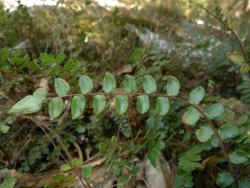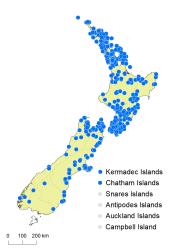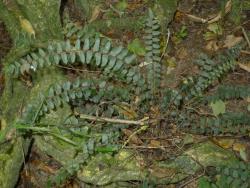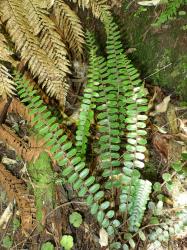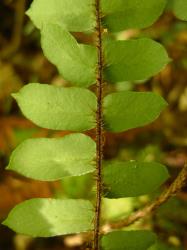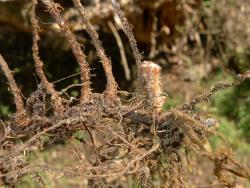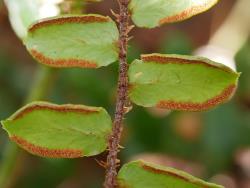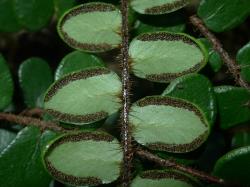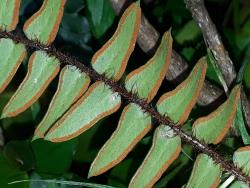- Taxon
- Gallery
- ≡ Pteris rotundifolia G.Forst., Fl. Ins. Austr. 79 (1786)
- ≡ Platyloma rotundifolia (G.Forst.) J.Sm., J. Bot. (Hooker) 4: 160 (1841)
- ≡ Allosorus rotundifolia (G.Forst.) Kunze, Linnaea 23: 10 (1850)
- ≡ Hemionitis rotundifolia (G.Forst.) Christenh. in Christenhusz et al., Global Flora, GLOVAP Nomenclature 1, 4, 20 (2018)
- = Pellaea rotundifolia var. oblongifolia Hook., Sp. Fil. 2, 136 (1858)
Rhizomes long-creeping, to 380 mm long (in herbarium specimens), 1–3 mm in diameter, densely scaly. Rhizome scales appressed, narrowly ovate, 1.6–3 mm long, 0.3–0.9 mm wide, with black occluded midribs and open orange-brown cells on the margins. Fronds ± monomorphic, 110–870 mm long. Stipes 20–310 mm long, dark red-brown, brittle, bearing abundant spreading orange-brown scales; stipe scales from short and hair-like to narrowly ovate with filiform apices, up to 6 mm long and 0.8 mm wide. Rachises dark red-brown throughout, bearing abundant spreading scales. Fertile laminae 1-pinnate or very rarely 2-pinnate, elliptic or narrowly elliptic or linear, 100–600 mm long, 12–72 mm wide, dark glossy green on adaxial surface, paler green abaxially, coriaceous; hair-like scales on costae and both lamina surfaces. Primary pinnae on fertile fronds in 8–40 pairs, orbicular or oblong or triangular, sometimes with a small basal acroscopic lobe on proximal pinnae; apices obtuse to acute, abruptly narrowed to a short sharp point; bases cuneate to truncate; the terminal pinna not usually enlarged. Very rarely, pinnae in the proximal half of the lamina divided into 1–2 pairs of secondary pinnae. Fertile pinnae not overlapping, the longest near the middle, 6–42 mm long, 4–16 mm wide, only slightly more widely spaced proximally, usually lacking obvious stalks on proximal pinnae; margins minutely toothed. Sterile pinnae sometimes longer or wider than fertile. Sori continuous along acroscopic and basiscopic pinna margins, not confluent at apices. Mean exospore diameter 32.9–36.8 μm; perispores echinate.
Plants of Pellaea rotundifolia on the main islands of New Zealand are distinguished from P. calidirupium by the presence of spreading scales on the stipes and rachises, less obviously dimorphic fronds, generally longer laminae (100–600 mm long cf. 30–240 mm long), more pairs of pinnae on the fertile fronds (8–40 cf. 2–22), absence of an enlarged terminal pinna, less widely spaced proximal pinnae usually lacking distinct stalks, and sori that extend around the pinna margins but are not confluent at the apices. The fronds usually have neat rows of pinnae compared to the irregular and untidy appearance of those in P. calidirupium. The fertile pinnae are rounded or oblong, with obtuse to acute apices abruptly narrowed to a short sharp point, unlike those in P. calidirupium, which are characteristically triangular, or slightly falcate, with tapering apices.
Plants of P. rotundifolia on the Kermadec Islands are slightly different morphologically to those on the main islands in having more appressed stipe and rachis scales, although not as consistently as those in P. calidirupium. Distinguishing the two species relies on the other characters outlined above. However, molecular evidence shows that P. rotundifolia on both the Kermadecs and the North and South Islands is distinct from P. calidirupium (Brownsey et al. 2020).
North Island: Northland, Auckland, Volcanic Plateau, Gisborne, Taranaki, Southern North Island.
South Island: Western Nelson, Sounds-Nelson, Marlborough, Westland, Canterbury, Otago, Southland, Fiordland.
Kermadec Islands, Three Kings Islands, Chatham Islands.
Altitudinal range: 0–900 m.
Pellaea rotundifolia occurs on the Kermadec and Three Kings Islands, and in lowland to montane areas throughout the North Island from Te Paki to Wellington. It ranges from near sea level, reaching 600 m near Puketitiri, Hawke’s Bay. It occurs in lowland to montane regions throughout the South Island, but is more abundant on the northern and eastern coastlines, with only scattered populations in the far south. It grows from about 20 m, reaching 900 m at Jordan Stream Reserve, Marlborough. It also extends to the Chatham Islands, but does not reach Stewart Island.
Also recorded from Norfolk Island, based on a Cunningham specimen (Kunze 1850; Hooker 1851–1858; Bentham 1878), but subsequently thought to be erroneous (Green 1994). Newly recorded, based on a single collection (AK 237733), by de Lange et al. (2005).
Pellaea rotundifolia occurs in podocarp, broadleaved and beech forest, under pines and other introduced trees, under mānuka, kānuka and scrub, and amongst grasses. It is found on stony banks, clay banks, rocky outcrops, coastal cliffs and scree, amongst boulders, on streambanks, river terraces, tracksides, roadsides, bush margins, swamp margins and at the base of tree trunks. It grows on greywacke, scoria, lava, andesite, rhyolite, schist, sandstone and limestone substrates, peat and sand.
There is evidence that Pellaea rotundifolia hybridises with P. calidirupium in areas where the two species occur together (Brownsey & Lovis 1990), and that the hybrids have aborted spores (e.g. CHR 147559, 385976, 386678, 387589).
There are genetic and subtle morphological differences between populations of P. rotundifolia on the Kermadecs and those in the rest of New Zealand, suggesting different origins for the two groups. However, the exact nature of these evolutionary origins is unresolved at the present time, and the morphological differences inadequately understood (Brownsey et al. 2020).
The Australian species Pellaea nana (Hook.) Bostock is morphologically very similar to P. rotundifolia. However, chloroplast DNA sequence data show that it is genetically distinct from both Australian P. falcata and New Zealand P. rotundifolia (Brownsey et al. 2020).



